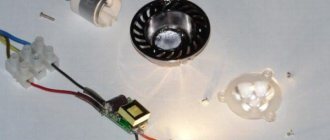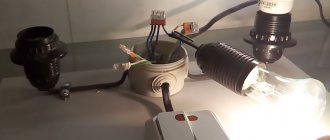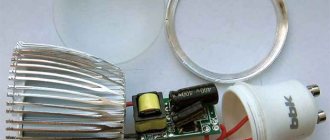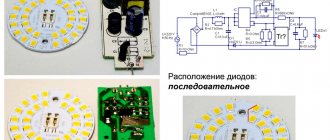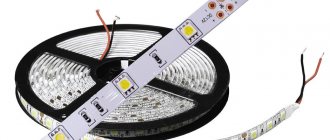LED strips save energy, last a long time, look good, are easy to install and use, have compact sizes, create pleasant diffused light, and emit minimal heat during operation.
However, during operation, an undesirable effect appears - the lights begin to blink.
It is possible to determine why an LED strip is blinking on or off only if you know how it is equipped.
How the LED strip works and what can blink in it
LED lighting is not only LED strip and connectors.
The system includes:
- driver;
- controller (amplifier and remote control);
- Dimmer.
The standard length of a flat dielectric LED strip is 5 meters. On one side there are diodes connected by conductive paths covered with plastic. The traces are the same as on printed circuit boards, but are supplemented with ballast resistance (resistors) to prevent flicker. On the other side there is glue covered with a film. The film is removed for installation.
Light bulbs are grouped in groups of 3. with serial connection and 6-12 pcs. when parallel, which allows you to cut the strip if necessary (for this there are images of a dotted line with scissors). There is a separate track on the LED strip for each circuit. The groups are equipped with contacts and instructions regarding polarity and voltage. If the light bulbs are very small, they are soldered in pairs to increase the intensity of the glow. Multi-colored pins are soldered to the end intended for connecting to power:
- zero (black) and phase (red) - for a single-color strip;
- black, red, blue, green - for RGB (color) strip.
At the opposite end, soldering or connectors are used for connection.
During installation, it is important not to confuse phase and zero. If you swap the green and blue wires, the tape will not fail, the wrong tracks will simply turn on.
Additional reasons
In addition to the reasons already listed above, the LED strip can cause blinking:
Power supply for tape
lack of power on the power supply. The voltage may simply “sag”. Normally, a “subsidence” of no more than 20% is allowed. It was precisely this 20% that was used to make a power reserve when designing wiring. If this is the reason, then blinking will not appear immediately, but only after heating the electronic elements and microcircuits;
- the presence of flux and acid residues on the LED strip after soldering its ends. Over time, the acid begins to corrode the copper base of the tape, causing the latter to blink when turned on;
- using connectors when cutting tape into pieces of the required length. Such areas can oxidize in damp areas (especially in new buildings). As a result, the contacts heat up and may burn out;
- connecting the tape directly to the electrical network. This applies to light sources with a voltage of 220 V. As a result of blinking one LED, the effect can spread to a section of the tape of approximately 1 m;
- using a strip of 3 led diodes. As a result, a malfunction of one tape causes the other two to blink;
- The battery in the remote control is dead.
Now the list of causes of blinking can be considered complete. To identify the cause of flickering, diagnose the components of the lamp: strip, power supply, remote control. When determining the reasons for the malfunction of the LED strip, you can determine the further path to solving the problem: repair or troubleshooting.
Why is any voltage ripple in a light source harmful?
SNiP 52.13330-2011 determined the permissible pulsation of lighting fixtures for industrial premises within the range of 12-20%. Scientists believe that flicker is harmful already at 5-8%. The voltage in the household network can vary within 190-240 V. At the minimum value, the pulsation level of the incandescent light bulb is maximum (22%), but does not violate SNiP.
If the LED strip and driver are of high quality, the ripple factor does not exceed 4%. This indicator is achieved by supplying direct current. You should not buy strips that are powered by alternating current. They can create a ripple of 40% even without a dimmer.
Increased pulsation of flickering light in an adult causes a feeling of fatigue, tension, and difficulty concentrating. Children develop pain and dryness in the eyes and increased fatigue, their mood drops, and they develop problems falling asleep.
Quality always
Certificate
Despite a rather impressive list of reasons that will answer the question “why is the LED blinking?”, this is far from a definitive list. After all, flickering may well appear in working condition due to poor quality of the product and its components. Blinking, as a visual effect, is very typical for cheap Chinese-made products, which are simply flooded with the lighting market today. Therefore, if you buy the products you need from stores that are questionable in terms of quality products, always keep your receipts. Since if the product turns out to be defective (it blinks or does not work at all after connecting to the power supply), you will have the opportunity to replace it with a better one. When purchasing an LED strip, always ask the seller for a quality certificate.
Its presence will serve as a guarantee that the lighting device you purchased will work as it should, and also meet all standards and technical specifications. Note! Buying cheap, low-quality products is fraught with rapid and frequent breakdowns, as well as a decrease in the level of safety of using the product at home. In addition, the service life is also reduced.
power unit
The most important element of a lighting system with an LED strip is the power supply (driver). It includes a capacitor that accumulates voltage. When the maximum volume is reached, the lights begin to blink in the on and off states.
Another important part of the driver is the rectifier bridge. If it fails, alternating current is supplied to the lighting fixture, causing increased flicker. A high-quality driver provides a voltage sag rate of more than 20%. If this indicator is less, when the current in the network decreases, the LED strip begins to blink, but not when turned on, but after all the parts of the microcircuit have warmed up.
Important! When purchasing cheap products, you must take into account that the stated percentage of subsidence may not correspond to the real one.
The LED strip can be powered by 12 or 24 V. Compliance can be checked with a multimeter.
Poor soldering
Chaotic blinking always indicates poor contact on bolts or soldering. Most often, this malfunction occurs if acid is used in combination with flux during soldering. They remain on the contacts and corrode copper if not thoroughly washed off. The lighting fixture begins to blink.
Contact oxidation on connectors
If connectors are used to connect pieces of tape, their contacts oxidize in rooms with damp walls. Under the influence of oxides, the compounds overheat and burn out. Most often this happens in new buildings, so in a new apartment it is better to use soldering when installing the system.
Faulty LED
Strips with a power supply consist of modules, each of them has 3 diodes. If one LED burns out, three blink. In mains-powered tapes, the diodes in the modules are connected in series. Each module contains 60 light bulbs. If one fails, the entire 1 meter long module blinks.
Controller and remote control
The purpose of the controller is to change the intensity of the glow of one color. The controller includes a main unit and a remote control. It is mounted between the driver and the LED strip. For large footage, additional blocks are installed between the tapes.
There are mechanical mini-models controlled by buttons on the body. The most common cause of controller failure is high humidity. You should buy models with an increased level of protection.
If the LED strip flickers, the remote control is checked first. Its functionality is reduced if the battery is low. Another common cause is sticking buttons, resulting in shorted contacts.
Other Possible Problems
The LED strip may blink for other reasons:
- improper installation of the strip (without protection or removal of excess heat);
- violation of the connection diagram;
- resource development.
If the LED strip is simply glued, the power is greater with a long length. The absence of a metal mounting channel contributes to contact failure due to overheating. Over time, the lights begin to blink during operation.
The most common mistake during self-installation is mixing up phase and zero. The reason for the confusion is the lack of markings on the switch. If a zero is connected to it, the LED strip blinks both when the light is on and off.
Poor soldering
It is prohibited to solder the LED strip with active (acid) fluxes. Otherwise, the acid will remain on the contact pad and will gradually corrode the connection.
An incomprehensible flash begins when the tape is turned on, followed by inoperability of the entire area after welding. Therefore, for such a connection, use only recommended materials and follow the welding rules.
If the contact is already corroded, you will need to cut the ribbon module and solder another one in its place.
It is also possible that the contact may overheat with an incorrectly selected soldering iron (more than 60 W). As a result, the copper block peels off from the track and an unstable joint appears.
Press with your finger - it lights up, release - it disappears. Hence the problems with flickering and blinking.
Troubleshooting and Troubleshooting
Diagnostics of all elements is carried out using a voltmeter (12 V multimeter):
- input voltage must be 220 V;
- output voltage of the power supply – 12 (24) V (2 V deviation is allowed);
- voltage on the dimmer and controller (12 V);
- voltage at the connections of individual diodes (7-12 V);
- remote controller.
When used to connect connectors, they also need to be checked.
Before checking the power supply, it must be disconnected from the controller and LED strip. The parameters of the power supply specified in the instructions do not always correspond to reality; the consumer receives a flashing LED strip. If the manufacturer has saved on parts, you should buy a device that meets the needs of a specific system.
Before going to the store, it is advisable to calculate the power supply based on the length of the strip. First, the need is determined from the table (for example, for an LED strip 1 m long with thirty elements, this is 7 W). This figure is multiplied by the total length and 0.3 (safety factor).
Important! The power supply does not always need to be changed. First you need to check whether the malfunction is caused by its location. For some models, functionality is reduced when installed in limited space.
If the dimmer or controller is broken, they must be replaced.
The switch backlight is also an LED. After someone turns on the light, it begins to interact with the LED strip. The best option is to replace the switch.
LED lamp repair. detailed instructions
Do-it-yourself repairs > Lighting > LED lamp repair. detailed instructions
Hello! Has your LED lamp stopped glowing? Then this article is for you. After all, many people think that it is difficult to repair an LED lamp on their own and often throw them away. And in vain! After all, the cost of LED lamps today relative to simple incandescent lamps is quite high.
From the practice of repair, it is easy to repair lighting devices based on LEDs, without having in-depth knowledge of electronics. At the same time, by repairing an LED lamp with your own hands, you can save a lot of money from your family budget.
LED lamp device
A simple low-power LED lamp consists of a housing, a base, a matte light diffuser, a block of LEDs, and a power supply driver (in cheap low-power LED lamps a simple transformerless rectifier is used).
Operating principle of LED lamp
Let's look at the operating principle of an LED lamp using an inexpensive Chinese one as an example. To do this, look at the diagram below
220V LED lamp circuit
A network voltage of 220 volts is supplied to the diode bridge rectifier circuit through the current-limiting capacitor C1 and resistor R2. At the output we obtain a constant voltage, which is supplied to the LED block HL1 through the current-limiting resistor R4. At the same time, the LEDs begin to glow. Capacitor C2 is designed to smooth out ripples of the rectified voltage. Resistor R1 is designed to discharge capacitor C1 when the power to the LED lamp is disconnected from the network.
How to repair an LED chandelier or lamp with your own hands
If a chandelier or lamp stops glowing, then first of all I recommend starting to check the presence of supply voltage supplied to the lamp. If, when you turn on the chandelier with the switch, there is no voltage on it, then you need to carefully check the electrical wiring. If voltage is present at the contacts of the socket where the LED lamp is screwed, then the reason is in the lamp.
DIY LED lamp repair
As I said above, an LED lamp consists of a power supply circuit and the LEDs themselves. You must first carefully disassemble the LED lamp and carefully inspect the power supply (rectifier) for external damage (burnouts of parts, burnt out traces of the printed circuit board). If this is not visually detected, then we proceed to checking the elements using a digital multimeter. Often the cause of the malfunction is a faulty current-limiting capacitor C1 with a capacity of 1 μF with a voltage of 400 volts. You can't check it without unsoldering it from the circuit. It is best to replace it with a known good one.
Checking the rectifier diodes is carried out using a multimeter. We switch it to diode measurement mode and call
If the capacitor and diodes are in good condition, pay attention to the condition of the current-limiting resistors R2 and R4. They may outwardly seem undamaged, but when dialed they may have a break
Checking the Lamp LEDs
Depending on its power, a lamp can have from several LEDs to several dozen.
Sometimes, when examining a board with LEDs, you can immediately see the burnout of some of them. Such LEDs must be replaced. Other LEDs also need to be tested with a multimeter or a voltage of 2.5-3 volts must be applied to them from an external source through an ohmic resistance of 100-200 Ohms. If they light up, then they are working properly. LEDs can be used from old LED strips. You are required to be able to use a soldering iron.
Why do LED lights blink?
The reason is that the lamp manufacturer used a low-quality current-limiting capacitor C1. Replace it with another one with a rated operating voltage of at least 400 volts. I don’t recommend setting it to 250 volts, as it will quickly fail and the entire circuit will simply smoke. My lamp is shining brightly after replacing the capacitor! ))
Good luck in repairing LED lamps and lamps based on them!
Main conclusions
The LED strip can be mounted on a dry wall or ceiling in a metal mounting channel. It provides ventilation and removal of excess heat. It is also important to protect the LEDs from mechanical stress. If individual elements are faulty, the strip heats up, which is not safe from a fire point of view.
Recommendations for choosing and purchasing:
- Before paying, you need to ask the seller to provide a quality certificate.
- If the product is cheap, you should keep the receipt. If a defect is detected, he will help make a replacement.
- When determining the footage, it is worth adding 2-3 meters for repairs.
The frequency between repairs is reduced if the equipment has real value and is offered by a trusted manufacturer.
Blinking must be eliminated. It increases the level of irritability of family members and negatively affects not only the eyes, but also the body as a whole. In addition to decreased vision, headaches and sleep disturbances may occur.
Contact oxidation on connectors
Not everyone likes and knows how to solder tape, so they connect it in another, more accessible way - with connectors.
However, they have a significant drawback - oxidation of contacts. Most often this happens in rooms where the walls have recently been painted, whitewashed or screeded.
That is, where there was excess moisture. The current flowing through the connector often exceeds 10A:
- for a 5m section with a power of 75W - 6.5A
- for tapes power 30 W per meter - 12.5 A
If the contact has oxidized, then at high current it will heat up and burn until it disappears completely.
The same thing can happen due to insufficient contact area of the contact pads, which is often observed in such connectors.
1 of 2
Therefore, it is recommended to carefully select connectors. Which of them are the most common and how to choose the best one, read the article “3 types of connectors for connecting an LED strip.”
How to find a non-working LED
From the information above, you learned that there are two ways to connect LEDs - serial and parallel (in groups). The most popular is the parallel method. In this case, if one LED fails, a separate (usually small) section of the flexible board will begin to flicker or stop working. The rest of the tape will continue to function in the specified mode.
To find a faulty LED, use the following recommendations:
- Inspect the tape visually, which often allows you to identify a burnt-out diode. If there are no obvious signs of burning, examine the surface of the semiconductor.
- A black dot on the crystal may indicate that the element has already burned out or is not working correctly. In general, you need to look for any defects that are not visible on adjacent parts.
- If you find a suspicious diode, call it. Perform a similar procedure for all other semiconductors in the non-working or incorrectly functioning area. You are not interested in compliance with technical standards - just compare the obtained values at each site separately.
- If you don't have a multimeter, use copper wire. Use it to short-circuit suspicious diodes. When you find a faulty one, when it is short-circuited, the circuit section will begin to operate normally.
- Never rule out the possibility of a manufacturing defect - poor soldering of the diode. Press it with a little force. If the problem is in the soldering, the LED will start to glow, as will the entire problematic circuit segment. In this case, re-soldering will help.
Despite the apparent complexity of the design of the LED strip, the presence of a large number of semiconductors, resistors and other circuit elements, you can independently identify the cause of flickering or malfunction of a separate section of the board. And even more so, when detecting defects, there is no need to run to the store for a new tape - perhaps the cause is a malfunctioning controller, power supply or remote control. First, try to perform independent diagnostics, and only then use the services of a specialist.
LED strips save energy, last a long time, look good, are easy to install and use, have compact sizes, create pleasant diffused light, and emit minimal heat during operation.
However, during operation, an undesirable effect appears - the lights begin to blink.
It is possible to determine why an LED strip is blinking on or off only if you know how it is equipped.
Shunting with a resistor
You can combat blinking by shunting the circuit with a certain resistance. To do this, take a resistor with a resistance of 1 mOhm and a power of 0.5 to 2 W. For safety, it is better to insulate it with heat shrink. The best connection location for the resistor is at the junction box. Connect it between the neutral and phase wires of the light bulb (in parallel with the energy-saving wire). It is especially convenient to connect this resistor through Wago clamps.
After this, your lamp will stop blinking.
If your junction box is hidden and there is no access to it (although this is already a violation), or there is no free space in it, then the resistor can be soldered directly to the phase and neutral wires of the chandelier. Then hide the ends in the terminal block.
The method has a big disadvantage.
In addition, modern electronic meters in the apartment will take into account the energy consumption for heating the resistance, and you will end up paying not only for lighting, but also for this “modernization”.
This is interesting: How to determine the utilization factor of grounding electrodes
Must be eliminated
If possible causes are discovered that lead to the LED strip flickering in operating condition, there are several ways to solve the problem. It is worth remembering that blinking LEDs must be eliminated even when this does not lead to damage to the light source. First of all, this is due to the fact that such flickering causes a number of negative phenomena:
- the nervous excitability of all family members increases;
- There is a negative effect of flicker on the visual system. The eyes quickly begin to get tired and watery, which after a while can lead to a decrease in visual acuity;
- disturbances in the general functioning of the body may also appear. Your head may begin to hurt, your sleep may be disturbed, or you may feel weak;
- It is possible to heat up individual elements of the tape structure.
Product flicker
Danger
Do not ignore such a breakdown! You cannot stay in this room for a long time. You read or work, write papers or sit at the computer, your vision is focused, and the flickering light adds to the strain. Increased irritability and fatigue develop, therefore, the load on the entire body increases.
A serviceable constant voltage LED strip ( 12 V – 24 V ), in contrast to an alternating current strip ( 220 V ), gives a low ripple coefficient not exceeding 4%. According to the standards of SP 52.13330.2016, this result is a completely safe indicator for humans, one might say optimal. Therefore, it is necessary to respond to flickering immediately and eliminate the cause of the problem.
Flickering light negatively affects the entire body as a whole.
Connecting a simple light bulb
And when the chandelier has several horns, instead of one energy-saving light bulb, you can place an incandescent lamp in parallel. The flashing should also stop. The method only works if there are several cartridges in one lamp and is probably the least expensive.
There are pros and cons here. The downside is that you lose the benefits of energy savings, for which you most likely switched to energy-saving devices. Plus, the lighting becomes more pleasing to the eye. Some jewelry workshops use just this kind of light.
Useful tips Connection diagrams Principles of operation of devices Main concepts Meters from Energomer Precautions Incandescent lamps Video instructions for the master Testing with a multimeter

